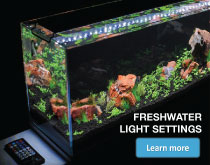How to Properly Acclimate Your Corals to LED Lighting
One issue reef hobbyists may encounter when upgrading to new LED lights is corals quickly losing their brilliant colors (bleaching). This is often attributed to stress caused by not allowing the corals to get properly acclimated to the new lighting intensity and color spectrum. When a coral bleaches, it is not dead, but it is under extreme stress and can die quickly. It's important for your corals (and other inhabitants) to gradually get accustomed to new lighting, especially higher intensity LED lighting.
Coral bleaching occurs when coral polyps become “stressed” and expel their symbiotic zooxanthellae (which is what gives them color). This often leads to a lighter colored or completely white appearance - hence the term “bleaching.” In nature, bleaching can be caused by a number of factors, including:
- Increased water temperature (mostly due to global warming) or reduced temperatures
- Increased solar brightness (PAR and ultraviolet UV light)
- Changes in water chemistry or salinity
- Bacterial infections
- Sedimentation, silt, and runoff
- Oxybenzene and other sunscreen ingredients that are non-biodegradable and can wash off of skin
- Herbicides or other pollutants
In reef aquariums, these same factors can also cause coral bleaching, especially an increase in light intensity. Switching from fluorescent lights to LED lights (or upgrading existing LEDs to higher intensity LEDs) can often cause a dramatic increase in PAR and/or a change in the color spectrum - so it's very important to slowly acclimate your corals to new lights.
How to acclimate CORALS under NEW LED LIGHTS
We've put together some simple tips for how you can gradually acclimate your aquarium and corals to LED lighting. It doesn't matter if you are going from older fluorescent lights to new LEDs or just upgrading to a higher output LED light; slow acclimation is recommended for any changes in lighting.
1) Raise your light fixture. This method is best if you're using a hanging kit, flexible gooseneck arm, or mounting arms like our adjustable tank mount brackets. Increase the mounting height a few inches, then slowly lower your light fixture over the course of 1-2 weeks.
2) Reduce your photoperiod. Most hobbyists run their aquarium lights a total of 9-12 hours per day, including a 1-hour sunrise/sunset. You’re safe to still run your sunrise/sunset lighting for the same time, but you should consider reducing the amount of time the daylight spectrum runs. Reduce the time period down to 6-9 hours per day instead of 10-12 hours. Add one hour of daylight each week until you’re back to your original lighting schedule.
3) Lower your daylight light intensity. This is usually the easiest method for acclimating your aquarium and corals to their new lights. Simply lower your daylight intensity by 20-30%, then gradually increase the overall daylight intensity by 10% each week until you are back to your original light levels.
4) Place new corals at the bottom of the tank. When introducing new corals, place them at the bottom of the tank for a few days, then place them up into position. This is a very successful way to slowly acclimate them to new lights.
No matter which method you use, always watch your corals and monitor how they are reacting to their new lights. If your corals begin to lose color and start turning white - slow down! Taking your time and being patient will always lead to a healthy, thriving reef aquarium and allow you to experience the full potential of your new LED lights.
**One additional tip
Once your corals and inhabitants are acclimated, try and keep things stable. When introducing new corals, stick with tip #4 above and don't alter your light intensity or schedule. Having a stable light cycle and keeping settings consistent is a key element for having strong coral growth and vibrant colors.



